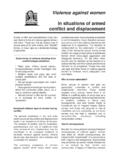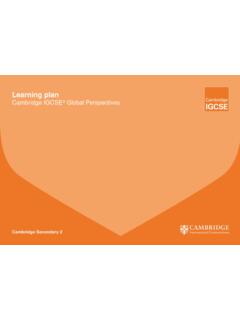Transcription of GLOBAL COMPACT ON REFUGEES - UNHCR
1 GLOBAL COMPACT on REFUGEES | IUnited Nations New York, 2018 GLOBAL COMPACT ON REFUGEESU nited NationsUnited Nations New York, 2018 IIUnited Nations New York, 2018 GLOBAL COMPACT on refugeesIIIU nited Nations New York, 2018 GLOBAL COMPACT on refugeesIntroductory note by the Office of the United Nations High Commissioner for REFUGEES ( UNHCR )The resolution on the Office of the United Nations High Commis-sioner for REFUGEES which affirms the GLOBAL COMPACT on REFUGEES (as contained in A/73/12 (Part II)) was adopted by the General Assembly on 17 December 2018 (A/RES/73/151).The resolution underscores the importance of the GLOBAL COMPACT on REFUGEES as a representation of political will and the ambition to operationalize the principle of burden- and responsibility-shar-ing, to mobilize the international community as a whole, and to galvanize action for an improved response to refugee situations.
2 It calls upon the international community as a whole, including States and other relevant stakeholders, to implement the glob-al COMPACT on REFUGEES , through concrete actions, pledges and contributions, including at the first GLOBAL Refugee Forum. It fur-ther calls upon States and other stakeholders that have not yet contributed to burden- and responsibility-sharing to do so, with a view to broadening the support base in a spirit of international solidarity and comprehensive refugee response framework set out in Annex I of the New York Declaration for REFUGEES and Migrants, adopted by the General Assembly on 19 September 2016 (A/RES/71/1), forms an integral part of the GLOBAL COMPACT on refu-gees; for ease of reference it has been reproduced at the end of the attached affirmation of the GLOBAL COMPACT on REFUGEES by the General Assembly represents the culmination of a two-year period of en-gagement and consultation with States and all relevant stakehold-ers, following the adoption of the New York Declaration for Refu-gees and Migrants in 2016, informed by practical experience with application of the comprehensive refugee response framework in a range of specific situations with the objective to ease pressures on the host countries involved, to enhance refugee self-reliance, to expand access to third-country solutions and to support condi-tions in country of origin for return in safety and , December 2018 IVUnited Nations New York, 2018 GLOBAL COMPACT on refugeesContents Paragraphs PageI.
3 Introduction ..1-9 1A. Background ..1-4 1B. Guiding principles ..5-6 2C. Objectives ..7 4D. Prevention and addressing root causes ..8-9 4II. Comprehensive refugee response framework ..10 5 III. Programme of action ..11-100 6A. Arrangements for burden- and responsibility-sharing ..14-48 71. GLOBAL arrangement for international cooperation: GLOBAL Refugee ..17-19 72. Arrangements to support a specific refugee situation ..20-30 National arrangements ..20-21 Support Platform ..22-27 Regional and subregional approaches ..28-30 113. Key tools for effecting burden- and responsibility-sharing ..31-48 Funding and effective and efficient use of resources ..32 A multi-stakeholder and partnership approach ..33-44 Data and evidence.
4 45-48 17B. Areas in need of support ..49-100 181. Reception and admission ..52-63 Early warning, preparedness and contingency Immediate reception Safety and security ..56-57 21 VUnited Nations New York, 2018 GLOBAL COMPACT on REFUGEES Registration and documentation ..58 Addressing specific needs ..59-60 Identifying international protection needs ..61-63 232. Meeting needs and supporting communities ..64 -84 Education ..68-69 Jobs and livelihoods ..70 -71 Health ..72-73 Women and girls ..74 -75 Children, adolescents and youth ..76-77 Accommodation, energy, and natural resource management ..78-79 Food security and nutrition ..80-81 Civil registries ..82 Statelessness ..83 Fostering good relations and peaceful 323.
5 Solutions ..85-100 Support for countries of origin and voluntary repatriation ..87-89 Resettlement ..90-93 Complementary pathways for admission to third countries ..94-96 Local integration ..97-99 Other local solutions ..100 40IV. Follow-up and review ..101-107 41 Excerpt from the New York Declaration, Annex I: Comprehensive Refugee Response Framework ..1-16 43 Reception and admission .. 5 44 Support for immediate and ongoing needs ..6 -7 45 Support for host countries and communities ..8 47 Durable 48 VIUnited Nations New York, 2018 GLOBAL COMPACT on refugeesGLOBAL COMPACT ON REFUGEESG lobal COMPACT on REFUGEES | Introduction1 United Nations New York, 2018I. IntroductionA. Background1. The predicament of REFUGEES is a common concern of hu-mankind. Refugee situations have increased in scope, scale and complexity and REFUGEES require protection, assistance and solutions.
6 Millions of REFUGEES live in protracted situations, often in low- and middle-income countries facing their own econom-ic and development challenges, and the average length of stay has continued to grow. Despite the tremendous generosity of host countries and donors, including unprecedented levels of humanitarian funding, the gap between needs and humanitari-an funding has also widened. There is an urgent need for more equitable sharing of the burden and responsibility for hosting and supporting the world s REFUGEES , while taking account of ex-isting contributions and the differing capacities and resources among States. REFUGEES and host communities should not be left The achievement of international cooperation in solving international problems of a humanitarian character is a core pur-pose of the United Nations, as set out in its Charter, and is in line with the principle of sovereign equality of Similarly, the 1951 Convention relating to the Status of REFUGEES (1951 Con-vention) recognizes that a satisfactory solution to refugee situa-tions cannot be achieved without international cooperation, as the grant of asylum may place unduly heavy burdens on certain countries.
7 2 It is vital to translate this long-standing principle into concrete and practical action, including through widening the support base beyond those countries that have historically con-tributed to the refugee cause through hosting REFUGEES or other Article 1(3), Charter of the United Nations; A/RES/25/2625. 2. Preamble, recital 4 (United Nations, Treaty Series, vol. 189, No. 2545). See also A/RES/22/2312, article 2(2). GLOBAL COMPACT on REFUGEES | Introduction2 United Nations New York, 20183. Against this background, the GLOBAL COMPACT on REFUGEES intends to provide a basis for predictable and equitable burden- and responsibility-sharing among all United Nations Member States, together with other relevant stakeholders as appro-priate, including but not limited to: international organizations within and outside the United Nations system, including those forming part of the International Red cross and Red crescent Movement; other humanitarian and development actors; inter-national and regional financial institutions; regional organiza-tions; local authorities; civil society, including faith-based organi-zations; academics and other experts; the private sector; media; host community members and REFUGEES themselves (hereinafter relevant stakeholders ).
8 4. The GLOBAL COMPACT is not legally binding. Yet it represents the political will and ambition of the international community as a whole for strengthened cooperation and solidarity with ref-ugees and affected host countries. It will be operationalized through voluntary contributions to achieve collective outcomes and progress towards its objectives, set out in para 7 below. These contributions will be determined by each State and rel-evant stakeholder, taking into account their national realities, capacities and levels of development, and respecting national policies and priorities. B. Guiding principles5. The GLOBAL COMPACT emanates from fundamental principles of humanity and international solidarity, and seeks to opera-tionalize the principles of burden- and responsibility-sharing to better protect and assist REFUGEES and support host countries and communities.
9 The GLOBAL COMPACT is entirely non-political in nature, including in its implementation, and is in line with the purposes and principles of the Charter of the United Nations. It is grounded in the international refugee protection regime, cen-tred on the cardinal principle of non-refoulement, and at the core of which is the 1951 Convention and its 1967 Some 3. United Nations, Treaty Series, vol. 606, No. 8791. GLOBAL COMPACT on REFUGEES | Introduction3 United Nations New York, 2018regions have also adopted specific instruments which apply to their own respective The GLOBAL COMPACT is guided by relevant international human rights instruments,5 international humanitarian law, as well as other international instruments as It is complemented by instruments for the protec-tion of stateless persons, where The humanitarian principles of humanity, neutrality, impartiality and independence A/RES/46/182 and all subsequent General Assembly resolu-tions on the subject, including resolution A/RES/71/127 as well as the centrality of protection also guide the overall application of the GLOBAL COMPACT .
10 National ownership and leadership are key to its successful implementation, taking into account nation-al legislation, policies and It is recognized that a number of States not parties to the international refugee instruments have shown a generous ap-proach to hosting REFUGEES . All countries not yet parties are en-couraged to consider acceding to those instruments and States parties with reservations to give consideration to withdrawing them. 4. See the 1969 OAU Convention Governing the Specific Aspects of Refugee Problems in Africa (United Nations, Treaty Series, vol. 1001, No. 14691); the 1984 Cartagena Declaration on REFUGEES ; and the Treaty on the Functioning of the European Union, article 78, and Charter on the Fundamental Rights of the European Union, article 18. See also the Bangkok Principles on the Status and Treatment of REFUGEES of 31 December 1966 (final text adopted 24 June 2001).














